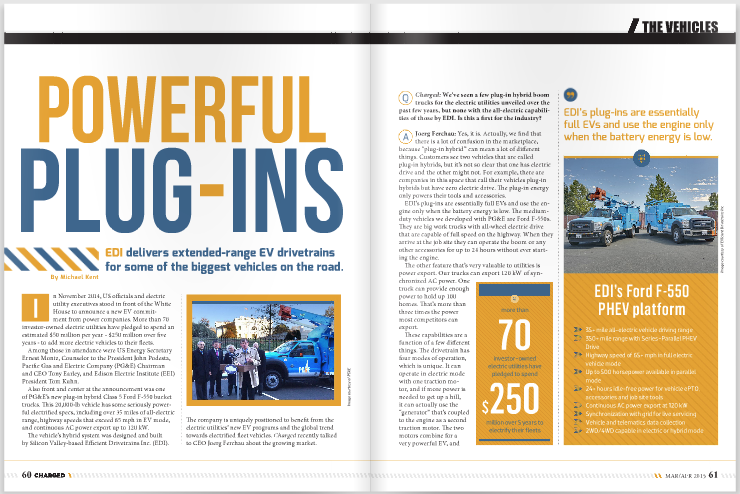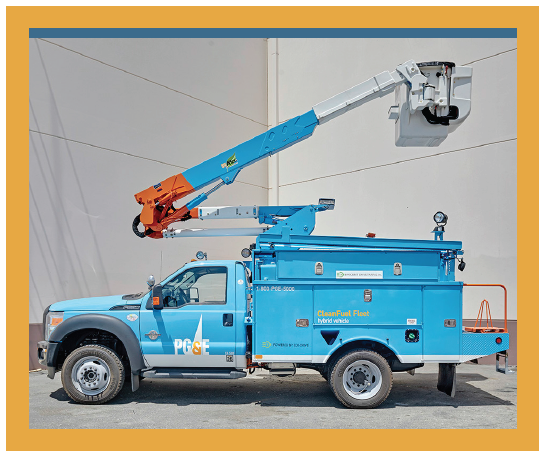Powerful plug-ins: Q&A with Efficient Drivetrains Inc. CEO Joerg Ferchau.
In November 2014, US officials and electric utility executives stood in front of the White House to announce a new EV commitment from power companies. More than 70 investor-owned electric utilities have pledged to spend an estimated $50 million per year – $250 million over five years – to add more electric vehicles to their fleets.
Among those in attendance were US Energy Secretary Ernest Moniz, Counselor to the President John Podesta, Pacific Gas and Electric Company (PG&E) Chairman and CEO Tony Earley, and Edison Electric Institute (EEI) President Tom Kuhn.
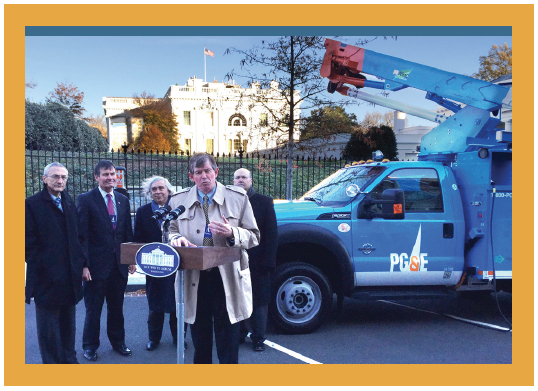

Also front and center at the announcement was one of PG&E’s new plug-in hybrid Class 5 Ford F-550 bucket trucks. This 20,000-lb vehicle has some seriously powerful electrified specs, including over 35 miles of all-electric range, highway speeds that exceed 65 mph in EV mode, and continuous AC power export up to 120 kW.
The vehicle’s hybrid system was designed and built by Silicon Valley-based Efficient Drivetrains Inc. (EDI). The company is uniquely positioned to benefit from the electric utilities’ new EV programs and the global trend towards electrified fleet vehicles. Charged recently talked to CEO Joerg Ferchau about the growing market.
Charged: We’ve seen a few plug-in hybrid boom trucks for the electric utilities unveiled over the past few years, but none with the all-electric capabilities of those by EDI. Is this a first for the industry?
Joerg Ferchau: Yes, it is. Actually, we find that there is a lot of confusion in the marketplace, because “plug-in hybrid” can mean a lot of different things. Customers see two vehicles that are called plug-in hybrids, but it’s not so clear that one has electric drive and the other might not. For example, there are companies in this space that call their vehicles plug-in hybrids but have zero electric drive. The plug-in energy only powers their tools and accessories.
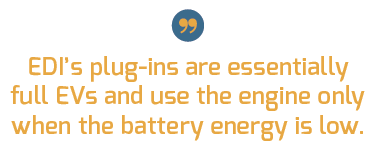

EDI’s plug-ins are essentially full EVs and use the engine only when the battery energy is low. The medium-duty vehicles we developed with PG&E are Ford F-550s. They are big work trucks with all-wheel electric drive that are capable of full speed on the highway. When they arrive at the job site they can operate the boom or any other accessories for up to 24 hours without ever starting the engine.
The other feature that’s very valuable to utilities is power export. Our trucks can export 120 kW of synchronized AC power. One truck can provide enough power to hold up 100 homes. That’s more than three times the power most competitors can export.
These capabilities are a function of a few different things. The drivetrain has four modes of operation, which is unique. It can operate in electric mode with one traction motor, and if more power is needed to get up a hill, it can actually use the “generator” that’s coupled to the engine as a second traction motor. The two motors combine for a very powerful EV, and when you don’t need it, the generator goes back to being a generator. That’s what we call EV and EV Plus modes.
The other thing that’s very unique about the truck is that it has two hybrid modes that kick in when the battery is low. For low-speed or city driving it’s most efficient to operate in series, so the engine is running and turning the generator to supply more energy to the batteries. Then when you get on the highway, you run in parallel mode – using both motors and the engine to provide power to the wheels in parallel mode.
The high power export capabilities are possible because we leverage everything on the vehicle to create AC power and export it – it’s designed from the ground up for that purpose.
Charged: So the power export function can power homes during emergencies?
Ferchau: Yes, but the utilities also have a different mission in mind. All of the power companies are rated by the minutes of customer downtime they have. So they’re always trying to find ways of reducing that. It turns out that the majority of their downtime is actually for planned outages when they’re doing things like swapping out transformers. With these plug-in vehicles you can roll into a neighborhood in all-electric mode, clip the truck to the power lines, export power off the batteries, and swap the transformer while it’s hot. There is no need to cut power to homes. PG&E, for example, has 1.25 million transformers in the state of California, and if it had enough of these trucks to do all hot swaps, its annual downtime would be drastically reduced. They are very excited about this.
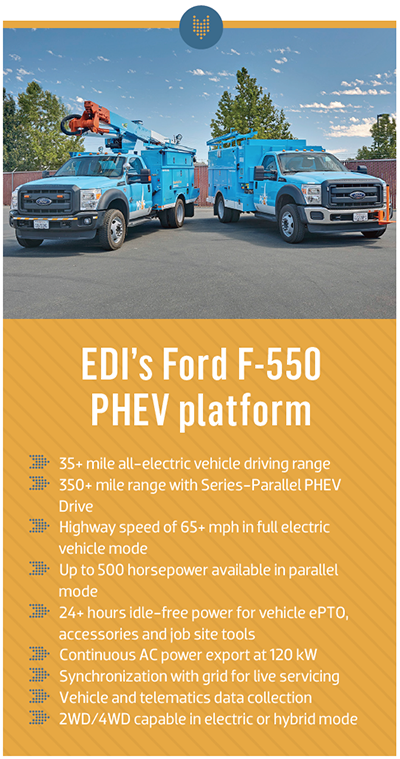

Charged: What’s the typical ROI for a utility company? Is it hard for them to digest?
Ferchau: For commercial vehicles, setting aside any emissions requirements, most operators want an ROI of around three years or less. Most hybrid and electric systems will have a payback between three and eight years. But that’s changing quickly.
For example, if we look at costs associated with batteries from 2006 to 2010, we didn’t see much of a decrease in costs. From 2010 to 2013, there was a small drop. But in the past 12 months, we’ve seen significant decreases in battery system costs. We’re also seeing new motor technology that’s smaller, with higher power and lower costs.
And there are other drivers beyond fuel savings. Back in 2007, the EV market was about environmental impacts, then it was about fuel prices, then energy security, then job growth, and so on. In the last 12 months it’s become more defined and largely driven by regulatory compliance, both here in the US and in China. Government policies are getting a lot more aggressive about fuel economy standards, emissions reductions, and no engine idling in certain environments like schools, hospitals, and city centers.
Every OEM on the planet is having to look at hybridization as a way to be compliant. And once you put batteries and motors into vehicles, customers become accustomed to the acceleration of electric launch. Before you know it, they want more electric range and power. It’s past the tipping point, it’s actually happening now and being driven by compliance and great functionality.
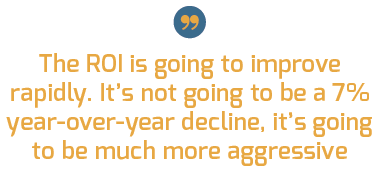

So, the ROI is going to improve rapidly. It’s not going to be a 7% year-over-year decline, it’s going to be much more aggressive. Today they’re still expensive, but the good news is that there is demand, systems are getting out into the field, everybody is getting more experience, and suppliers are seeing more volume and are bringing costs down.
Charged: EDI has designed drivetrains for many other vehicles as well. Tell us about your design architecture.
Ferchau: We use what we call an open or modular architecture. Batteries and motors are sourced from best-of-breed companies in the US, Europe, Korea, Japan, and China. The idea is to always have the ideal battery and motor that is right-sized for the vehicle application. That way we have the best price performance on the road. We treat the battery as a black box, agnostic to chemistry. We create the requirements for the battery module and then we bring in the best chemistry and company for the purpose.
Most of our IP is in the control software. When you have a hybrid drivetrain, it’s a pretty complex thing to manage. You’re managing engines, clutches, generators, motors, batteries, chargers and more. The way that you control power and energy with software is very critical to efficiency.
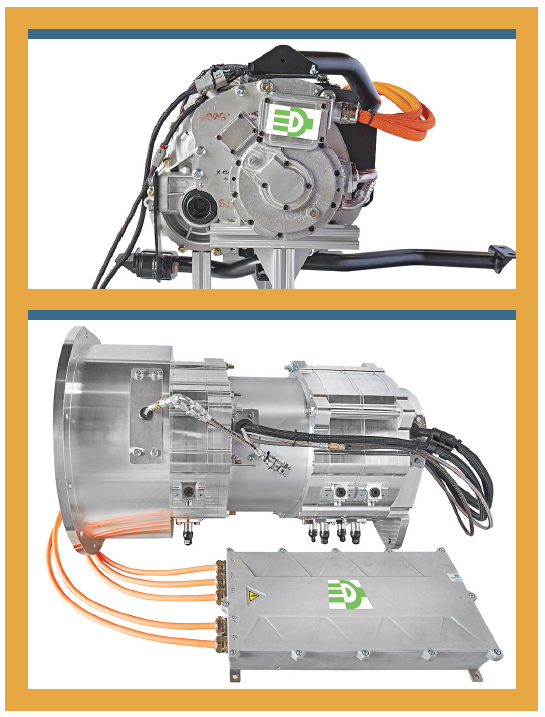

The company was founded in 2006 as a technology spin-out of University of California, Davis. They had done about ten years of R&D on the technology and got to a point where they decided to commercialize the patents. Over the past four or five years at EDI we’ve significantly expanded the IP and now have a great patent portfolio. One of the challenges of bringing a new technology to market is that it’s hard to get an industry position without IP. You can even be blocked from entering the market, so having some sort of IP behind you is a really important thing. EDI’s patent portfolio is extensive and covers things like hybrid vehicle architecture, control algorithms and transmission technology.
From the very beginning the business plan was to develop plug-in hybrid drivetrain solutions for commercial and fleet vehicles, with a primary focus on medium-duty markets. Years later, that’s still our sweet spot. Medium-duty generally means Class 3 to Class 6 vehicles, that’s roughly 6,000 to 26,000 lbs gross vehicle weight. We’ve also done some lighter-duty trucks and city and highway buses.
All of the drivetrains we’ve developed share the same architecture as the Ford F-550s we delivered to PG&E – that is, plug-in hybrids that are full-power EVs until the battery is depleted and they switch to hybrid modes. We’ve developed a very unique open architecture that has lower cost, smaller size, and less weight, and we use the same system for everything from small vehicles up to large buses.
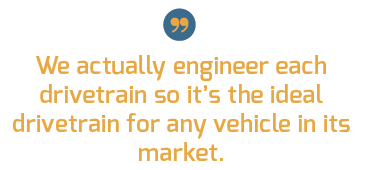

Most other companies have a drivetrain solution, then they try to force it to fit a certain application. We actually engineer each drivetrain so it’s the ideal drivetrain for any vehicle in its market. Because our architecture is modular, we can bring in the right motors and batteries based on the size of the vehicle, cost targets, and performance requirements, then use the same control software for a small pickup truck in the US or a 50,000 lb highway bus in China.


Charged: Does EDI design the drivetrains and then license the technology, or do you manufacture vehicles as well?
Ferchau: Whenever you start a new company there is always a learning curve. You have your vision of the business plan and then you’re hit with reality and you have to adapt. This is one area where we’ve made a few adjustments to the model.
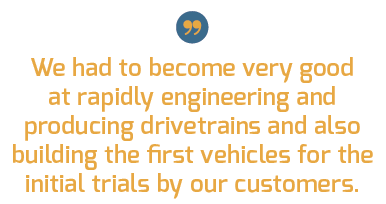

The plan was always to be a drivetrain technology provider, but we learned early on that while our customers liked the technology, they didn’t have the experience or culture to actually build the first vehicles. So we had to become very good at rapidly engineering and producing drivetrains and also building the first vehicles for the initial trials by our customers. Last quarter we built about 20 vehicles, and this year, we’ll do significantly more.
To answer your question, our main business model is to help our customers develop and build the first vehicles using our technology and our drivetrains, whether it be an OEM, an upfitter or a fleet manager. Then once they go to the market and mass production, we’ll become the supplier for things like control software, controllers, and some drivetrain subsystems.
In concept, we do low-volume manufacturing, and once the vehicle is tested and certified, our goal is to turn that over to our customers and just provide them with drivetrain technology. It may sound like we’re doing a lot of different things at once, but we’re actually very focused.
Charged: Can the drivetrains be retrofit to used vehicles, or only installed at the beginning of the manufacturing process?
Ferchau: We can do it either way. OEMs can set up a production line to install our drivetrains, or they can be retrofit. The chassis and the body remain unchanged, so you can build them new or install our drivetrains down the line. Today, EDI often functions as the upfitter. Customers buy new vehicles and provide them to us to be hybridized.
Charged: What are some of the other vehicles that EDI has developed drivetrains for?
Ferchau: We have a lot of development programs here in the US and also in China. We set up wholly owned subsidiaries in China, and our business is expanding.
Some of the recent projects include a plug-in hybrid system for a GM-based Class 3 utility pickup truck, PHEV CNG city buses, and low cost PHEV SUVs.
We’ve done plug-in hybrids using gas engines, diesel and compressed natural gas (CNG).
One CNG-based PHEV system – in partnership with Greenkraft, CALSTART, and the California Energy Commission – is a 14,500 lb, Class 4 medium-duty delivery truck. It achieved an MPGe of 26.9.
In another partnership with the Chinese bus company Euease, we developed a low-cost CNG PHEV bus. It’s manufactured entirely in China with local components and EDI control systems. It runs in all-electric mode for about 20 to 30 miles per day, and can also use opportunity charging to go further, including CNG hybrid operation for extended ranges.
This year in China we’re also starting to do some pure electric projects. These will actually be government and consumer vehicles. Our focus has always been commercial and fleet, but in China the government is starting to buy smaller electric vehicles. So we’re building some EV versions of SUVs and five-passenger sedans.


Charged: How many vehicles powered by EDI drivetrains are on the road today?
Ferchau: A lot of our customers received the first vehicles powered by EDI technology in 2014. In China, for example, we recently received government certification, which was a huge milestone for us. So, last year we were continuing to build the initial units for the first trials and the shakedown efforts. This year is about ramping up more production, and next year we’ll be focused on going into more mass production. This year we expect to have about 100 vehicles being tested with our drivetrains. Next year we expect it to be in the thousands. And the really interesting part of our story is the variety of those vehicles.
This article originally appeared in Charged Issue 18 – March/April 2015.




